Puget Systems Echo: Intel and AMD Showdown at 65 Watts
by Dustin Sklavos on March 21, 2012 2:35 AM EST- Posted in
- Systems
- AMD
- Intel
- Mini ITX
- Sandy Bridge
- Llano
- boutique
- Mini-Tower
System Performance
When I started testing these two systems from Puget Systems I honestly wasn't prepared for the kind of tug of war that would occur. Fundamentally, the expected results are on the page: the Intel CPU outclasses the AMD APU at every turn, while AMD's integrated graphics hardware thoroughly outclasses Intel's. I'm not going to lie either, the results are about what you'd expect. What impressed me was just how wide the gaps were. Take a look.
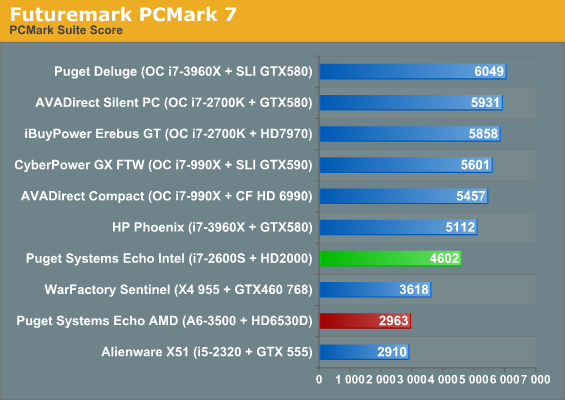
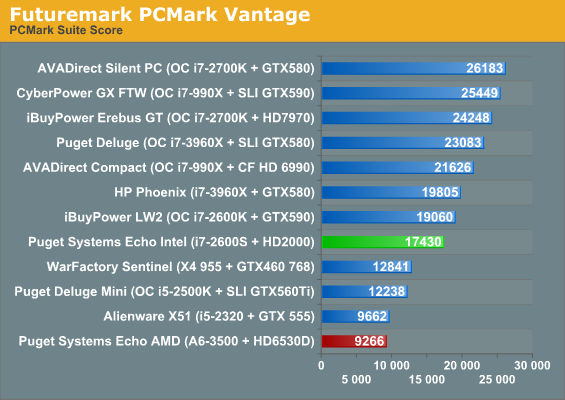
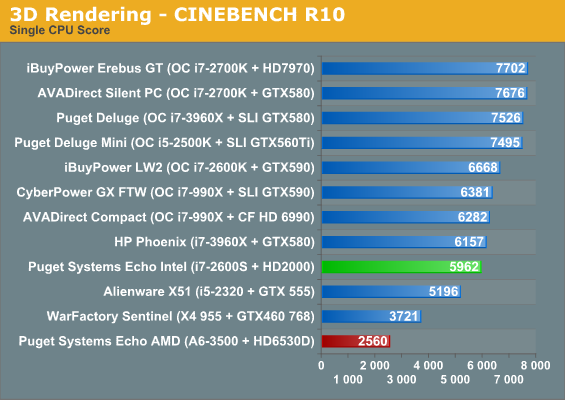
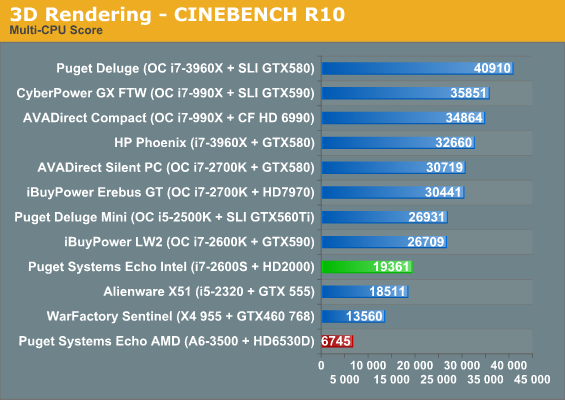


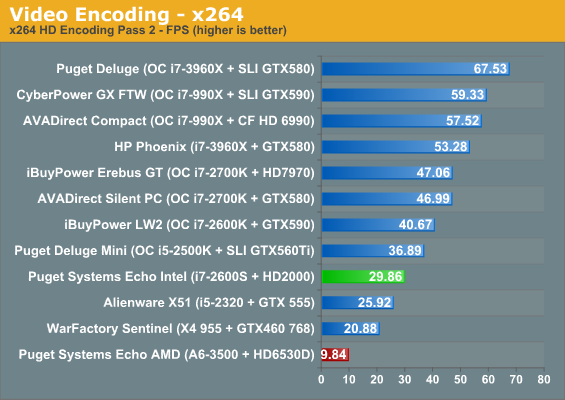
While the A6-3500's CPU performance would certainly be fine for a notebook, it's absolutely lousy on the desktop. Granted much of our competition is pretty unfair, with overclocked systems abounding, but look at how badly it even struggles against a last-generation Phenom II X4 955, much less the Intel Core i5-2320 in the Alienware X51. The i7-2600S is consistently two-to-three times faster in roughly the same power envelope.
To be fair, though, these results need to be framed in a more meaningful way than just "the A6-3500's CPU is dog slow." We need to consider the environments in which these systems are going to be used, and at the risk of sounding like an AMD apologist, I don't see many situations where the Intel chip's mammoth lead on the A6-3500 is going to be relevant. The A6-3500 is fine for basic Photoshop work, and neither of these systems are really ideal for serious video editing, where you need a much faster storage subsystem and CPU/GPU than either can provide either internally or externally.
Where a computer is much more likely to see frequent (if casual) use is in trying to run games, and here's where things take a turn.
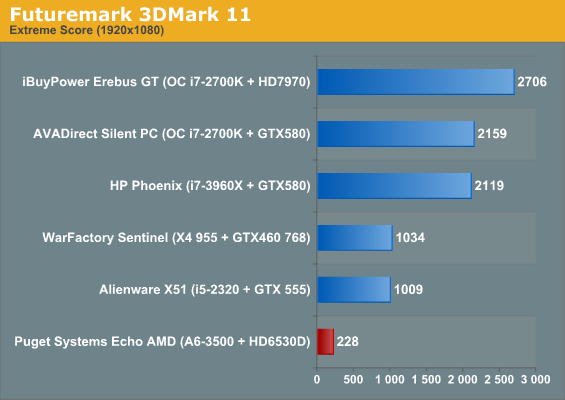


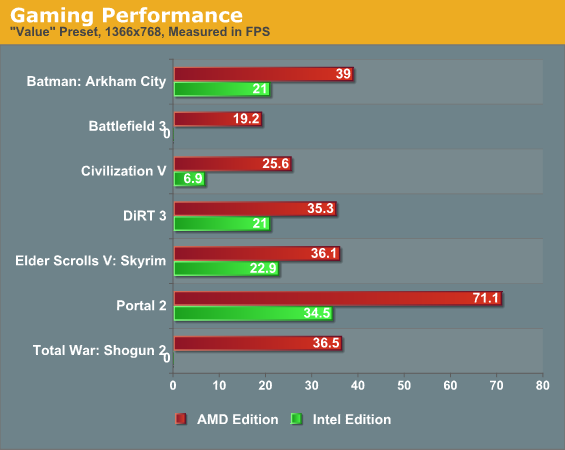
The Intel Core i7-2600S with its crippled IGP can't even run two of our benchmarks, and only produces playable performance in one of them: Portal 2, with its ancient (albeit updated) Source engine. Meanwhile, the Radeon HD 6530D inside the A6-3500 can stretch its legs and deliver playable performance across every game except Battlefield 3, where a dip in resolution or settings will render that game playable as well.
Granted, these are conservative settings at a relatively low resolution, but the point remains that if someone wants to play a game on the A6-3500, they can, and reasonably comfortably. I've seen someone suddenly decide they want to try and play a game only to discover their system's integrated graphics can't handle it at all, and forums are rife with threads of people asking how to upgrade the graphics of their cheap desktops or their notebooks being met with the same answer: "you're screwed." With larger desktop systems, it's a different matter, but for mini-ITX and laptops you have to be prepared to live with whatever graphics the system includes from the factory.










62 Comments
View All Comments
ReverendDC - Monday, March 26, 2012 - link
Folks:This was a review of two pre-configured systems. In the end of the article, the author specifically states that there are far more powerful AMD CPUs available in the same power envelope, but they are not readily available, even on NewEgg, and that the manufacturer doesn't add them in as an option.
If I were an AMD fan (and I am...), I would be ecstatic that my admittedly lower-end CPU/GPU combo knocked out the MUCH more powerful i7 CPU/GPU combo for overall usefulness. I believe that competition is absolutely necessary in the CPU space - just look and see how much Intel is sitting on their laurels right now without a really good challenger to their CPU dominance right now, and then look how much work they are putting into the GPU side of things now that AMD has eaten their lunch in that arena. How could you claim that this article was written by an Intel fellow when the parting thought was that he would go with the AMD solution for a system such as this (notebook, HTPC)?
In addition, the author basically chastises the manufacturer for not making better parts available that would take advantage of the AMD's love of memory without even coming close to breaking the power consumption limit.
Come on, guys. We all know that the CPU side of AMD is not the reason people buy APUs. We all know that, until AMD drops the new NetBurst architecture they are trying to push (Bulldozer) and realize that, if Intel failed with that strategy, AMD may just go bankrupt using it, that Intel will DESTROY AMD on the CPU side. We also know that, even with Ivy Bridge, there is a good chance that the GPU side will STILL belong to AMD, even at current Llano builds (there is a previous article from Anand previewing the new Ivy Bridge GPU). There was not a single shock in this article. Why argue well-documented facts at this point....
Thanks for your time.
djfourmoney - Thursday, April 12, 2012 - link
What do mean they have qualified 1600Hz memory for the Llanos? Tom's already ran its own testing and PNY Xlr8 are the best given the price, availability and performance.Given faster memory the Llano would put a further smack down on Sandy Bridge graphics and run BF3!
These APU's are perfectly suited for HTPC use, especially given the price of cut down i3's (G-series).
I was wondering if this would run on the 90W power brick Antec gives you. I have A6-3500 waiting for a motherboard and memory. I sort of want to downsize my HTPC which uses a Sonta III case currently. But that would mean buying at least one external device and leaving my poor PCI TV Tuners out to lunch.
All total it would add $80 for the Antec case, $45 for a used 650HD USB Combo Tuner (ATI has better PQ chips!) and $15 for the ASRock board over the Mico-ATX version.
Oh well... Serious Budget Upgrade so I'll likely stick to the original plan. Thanks for the Review.